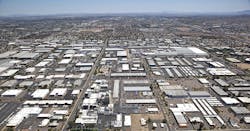After years of record growth, the industrial estate market in the United States is expected to remain healthy in 2023 in spite of inflation and a threatened recession that could stall some of that progress.
“The U.S. industrial market is continuing to see robust demand, and companies are adding warehouse and distribution space to protect their inventories, diversify their supply chains and process growing e-commerce sales,” says John Morris, president of Industrial & Logistics in the Americas for CBRE, which recently released its annual Industrial Occupier Survey.
“Even with a more challenging economic backdrop, we’re still seeing that companies are interested in expanding their footprints in the short-term,” he adds. Occupiers are still in expansion mode, the survey found, led by third-party logistics (3PL) providers and companies in the food and beverage and the building materials sectors.
CBRE reports that 64% overall and 81% of 3PL companies responding plan to expand their real estate footprint over the course of the next three years, in spite of economic uncertainty. Of these companies, 47% say that they are planning to expand by more than 10%, while 29% say they plan no change, but only 7% expect to downsize.
When it comes to building more space 3PLs are in the lead with 81% planning to expand their footprint over the next three years, while 75% of both food & beverage and building materials & construction companies will do the same.
On the other hand, most manufacturers say they are not planning a change in their footprint, with only 25% expecting to expand. 3PLs also play an important role in warehouse and distribution center space expansion plans: 66% intend to lease on open market (second-hand facilities), while 44% say they will partner with a developer to lease build-to-suit facilities.
At the same time, 37% intend to purchase land and self-develop their own facilities. However, 31% say they are planning to meet their future space needs by operating in customer-owned facilities—meaning 3PL warehouses.
“We’re seeing historically low vacancy rates, record rent growth and robust leasing activity, all of which has fueled significant development nationwide,” the company says. Given the current economic headwinds, the question inevitably arises, will these trends continue to be sustainable?
“While the secular drivers of demand endure, uncertainty about the economic outlook, labor markets and supply chains has impacted occupier sentiment and decision-making,” the CBRE researchers stress.
Top Occupier Priorities
Occupiers are looking for different warehouse characteristics when assessing how much rent they are willing to pay, CBRE found. When it comes to the top decisive factors for building selection, nearly three-fourths (74%) of the occupier respondents cited occupancy cost (rent) as the top factor when selecting a building within a market.
The occupiers polled said this priority was followed by lease options (50%), transportation (47%) and building design (45%). Other important factors considered during site selection, although weighted less heavily, include quality of local infrastructure, developer or owner reputation, and sustainability rating.
Regarding essential building features, distributors and e-commerce occupiers have returned to a “bread and butter” mentality, according to CBRE. When selecting a new warehouse, 81% of occupiers identified clear height as one of the most important building features.
Other features sought out most often include power supply (81%), the total number of loading bays/dock doors (76%), column spacing (76%), and the capacity for expansion (76%). Power supply is top of mind given heavy use of electricity from manufacturers and warehouse operators; and this also is expected to continue driving site selection, CBRE says.
“Major distributors and e-commerce occupiers require highly functional properties to process high volumes and need modern buildings containing such features,” CBRE says. This is a primary factor fueling the record 662 million square feet of new development underway in the United States.
“The average age of a U.S. warehouse building is 43 years, and 28% are more than 50 years old,” the company points out. “Given the continued growth of e-commerce and retailer omnichannel offerings, warehouses approaching obsolescence in these markets will present opportunities for redevelopment, particularly in locations that support last-mile delivery.”
When it comes to the major supply chain challenges facing occupiers, 61% of respondents report that labor availability is a major impediment for the growth of their business, while 58% say they are most concerned about rising rents.
In regard to the labor shortage 78% of responses pointed to improving wages and conditions and 49% to improving training programs as solutions.
“The fact that occupiers are improving conditions for workers and looking to increase automation means they are expecting leaner operations with more skilled labor,” CBRE observes. Seen as less important strategies for employee recruitment and retention are wellness programs and promoting the company’s sustainability credentials.
In addition, 48% point to the challenges they face from higher transportation costs. “Occupancy costs account for just 3% to 6% of total logistics spend, whereas transportation costs account for about half to as high as 70% of total spend,” CBRE explains. “However, rents are rising rapidly, so occupiers clearly have sticker shock.”
Other concerns include the lack of suitable warehouse/manufacturing space and inflexible lease options. Top industries represented in these responses include 3PLs, electronics and appliances, building materials and construction, and food and beverage manufacturers.
To address environment, social and governance (ESG) considerations, occupiers are planning to meet their net-zero carbon targets via their real estate footprint by switching to LED lighting, using alternative energies on-site and using electric material handling equipment. Other responses include adding electric charging points for delivery fleets and capturing rainwater.
In regard to sustainability, three-fourths (75%) of occupiers told CBRE that they would be willing to pay higher rents to switch to green energy. The majority also said they would be willing to pay more if the savings on future operational costs would be matched. Still, more than a quarter said they would not be willing to pay a premium to switch to green.
Geography Is Destiny
When it comes to preferred locations, more than a third of respondents told CBRE that they plan to expand in the Southeast over the next 12 to 24 months. This region boasts several large logistics hubs serving growing population centers, large affordable labor forces and seaport connectivity.
The Southeast also benefits from a supportive business climate for manufacturers, CBRE points out. Growing industrial markets like Atlanta, Nashville, Orlando, Charleston and Charlotte also are attracting occupiers in need of additional warehousing or manufacturing facilities.
Other regions that were ranked highly as targets for expansion include the Southwest and the Midwest, where markets like Reno, Phoenix and Minneapolis have become optimal locations for occupiers because of their strong demographics and infrastructure, which support additional industrial demand.
Another geographic imperative was examined by CBRE in a separate study analyzing warehouse and distribution center rents near the 20 busiest airports for airfreight in the U.S. That analysis found the average rents for warehouse space within a five-mile radius of these airports are 18.8% higher than the average rent for their metropolitan areas.
The firm explained that warehouses in close proximity to major airports are coveted by shippers who need to use the speed of airfreight to transport high-dollar goods packaged in small enough sizes and quantities to fit on airplanes. It notes that supply of such warehouses is limited in many dense airport submarkets, such as those surrounding JFK in New York, LAX in Los Angeles and Miami International.
“The immediacy of e-commerce deliveries and the generally faster pace of business than in past decades, among other factors, have made airport warehouses a critical link in many supply chains,” says Morris. “Rents for these properties will continue to exceed their market averages for the foreseeable future.”
The research found that the largest share—42.7%—of leasing activity in airport-warehouse markets so far this year was pursued by 3PLs. This represents a greater share of the overall airport warehouse market than the 3PL’s position in regard to overall U.S. warehouse leasing, which comes in at 35.6%.
The reason is that shippers, retailers and other companies often hire 3PLs to handle shipping of small-lot goods via high-cost airfreight, CBRE says. The second largest share of leasing activity near airports was taken up by general retail and wholesale companies at 32.2%. Food and beverage companies are a distant third place at 5.2%.
About the Author

David Sparkman
founding editor
David Sparkman is founding editor of ACWI Advance (www.acwi.org), the newsletter of the American Chain of Warehouses Inc. He also heads David Sparkman Consulting, a Washington D.C. area public relations and communications firm. Prior to these he was director of industry relations for the International Warehouse Logistics Association. Sparkman has also been a freelance writer, specializing in logistics and freight transportation. He has served as vice president of communications for the American Moving and Storage Association, director of communications for the National Private Truck Council, and for two decades with American Trucking Associations on its weekly newspaper, Transport Topics.
